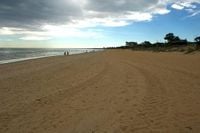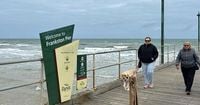It was supposed to be a typical afternoon by the sea, but on October 22, 2025, the waters off Melbourne’s Frankston Pier became the stage for a tragedy that would reverberate across Australia and beyond. As a fierce storm battered Victoria state with wind gusts up to 130 kilometers per hour (81 mph), two men—one a British national new to surfing, the other a local friend—lost their lives in a desperate struggle against the elements.
According to Associated Press and The Independent, the incident unfolded around 5 p.m. local time. Emergency services were summoned to Frankston Beach in Melbourne’s southeast after reports that two men were in distress in the water. The city was already grappling with the effects of the storm: trees and branches littered the streets, and thousands of homes and businesses were plunged into darkness by widespread power outages.
Detective Inspector Melissa Nixon of Victoria Police recounted the sequence of events to reporters the following day. A 36-year-old British man, who had settled in suburban Frankston, had decided to surf despite the wild weather. “The surfer was obviously in distress. He was struggling in the water after the surfboard broke. He wasn’t experienced at surfing ... His friend obviously saw he was in distress and jumped in to help him,” Nixon explained, as quoted by AP.
That friend, a 43-year-old local, didn’t hesitate to leap into the churning surf. But the rescue attempt quickly turned perilous for both men. As the wind howled and waves crashed, their situation grew dire. Authorities believe the British national’s board snapped amid the rough surf, leaving him especially vulnerable given his lack of experience—he “may have only been learning to surf,” Nixon said, echoing statements reported by The Independent.
Emergency services, including a police rescue helicopter, rushed to the scene. The helicopter crew managed to locate and winch both men from the water. But despite the rapid response and valiant efforts, neither man could be revived. Both were pronounced dead at the scene, with formal identification pending as police worked to notify next-of-kin.
The tragedy did not end there. One of the emergency responders—a police tactical operator involved in the rescue—was hospitalized overnight after taking in “a large amount of water,” Nixon confirmed. Thankfully, he was discharged the next day, but the ordeal underscored the dangers faced not just by those in trouble, but by the people who risk their lives to save them. “He’s had to go in twice,” Nixon noted. “As I said, they’re very experienced. They do this often.”
For many, the story is a haunting reminder of how quickly a simple day at the beach can turn catastrophic, especially when nature’s fury is involved. The storm that swept through Melbourne and wider Victoria state that evening wasn’t just a backdrop—it was a central character in the unfolding drama. The wind’s ferocity toppled trees, snapped branches, and left thousands without power, complicating rescue efforts and heightening the sense of chaos. As Nixon told the press, “The weather conditions yesterday were obviously not appropriate to be in the water surfing, whether you’re experienced or not. It is a risk that you take that you put other people in danger.”
Her warning was stark and clear: “Do not go swimming or surfing in conditions like this when we know that it’s going to be treacherous conditions. You put yourself at risk. You put people that jump in to help you at risk. You put the emergency services at risk.”
Melbourne is no stranger to unpredictable weather, but the storm that struck on October 22 was particularly severe. Wind gusts rivaled the force of a small hurricane, and the sea took on an angry, unwelcoming character. For those who live by the water, the temptation to brave the surf—even in wild weather—can be strong. Yet, as this tragedy demonstrates, the ocean’s allure is matched only by its capacity for danger.
The deaths of the two men have prompted reflection within the local community and beyond. Frankston, a suburb with a vibrant beach culture, is mourning the loss of both a resident and a relative newcomer. The fact that the British national was likely a beginner at surfing only deepens the sense of sorrow and frustration—his enthusiasm for the sport, cut short by a cruel twist of fate.
The incident also shines a light on the selflessness that so often emerges in moments of crisis. The 43-year-old friend’s decision to plunge into the storm-tossed sea, risking—and ultimately losing—his own life in a bid to save another, speaks to a kind of everyday heroism that rarely makes headlines. “His friend obviously thought he was in distress and jumped in to help him,” Nixon said, her words carrying both admiration and regret.
But the tragedy has also sparked renewed calls for caution and respect for the sea’s power. Authorities are urging the public to heed weather warnings and to think twice before entering the water during storms, regardless of their swimming or surfing ability. “You put yourself at risk. You put people that jump in to help you at risk. You put the emergency services at risk,” Nixon reiterated, hoping to prevent future loss of life.
As the city recovers from the storm’s aftermath—clearing fallen trees, restoring power, and comforting those affected by the tragedy—the lessons of October 22 linger. The sea, for all its beauty and promise of adventure, remains a force to be respected. And while the courage to help others is a quality to be celebrated, it is also a reminder of the fine line between heroism and heartbreak.
For the families and friends of the two men, and for the wider Melbourne community, the events at Frankston Beach are a somber testament to the unpredictable dangers of nature—and the enduring human impulse to help, no matter the cost.





